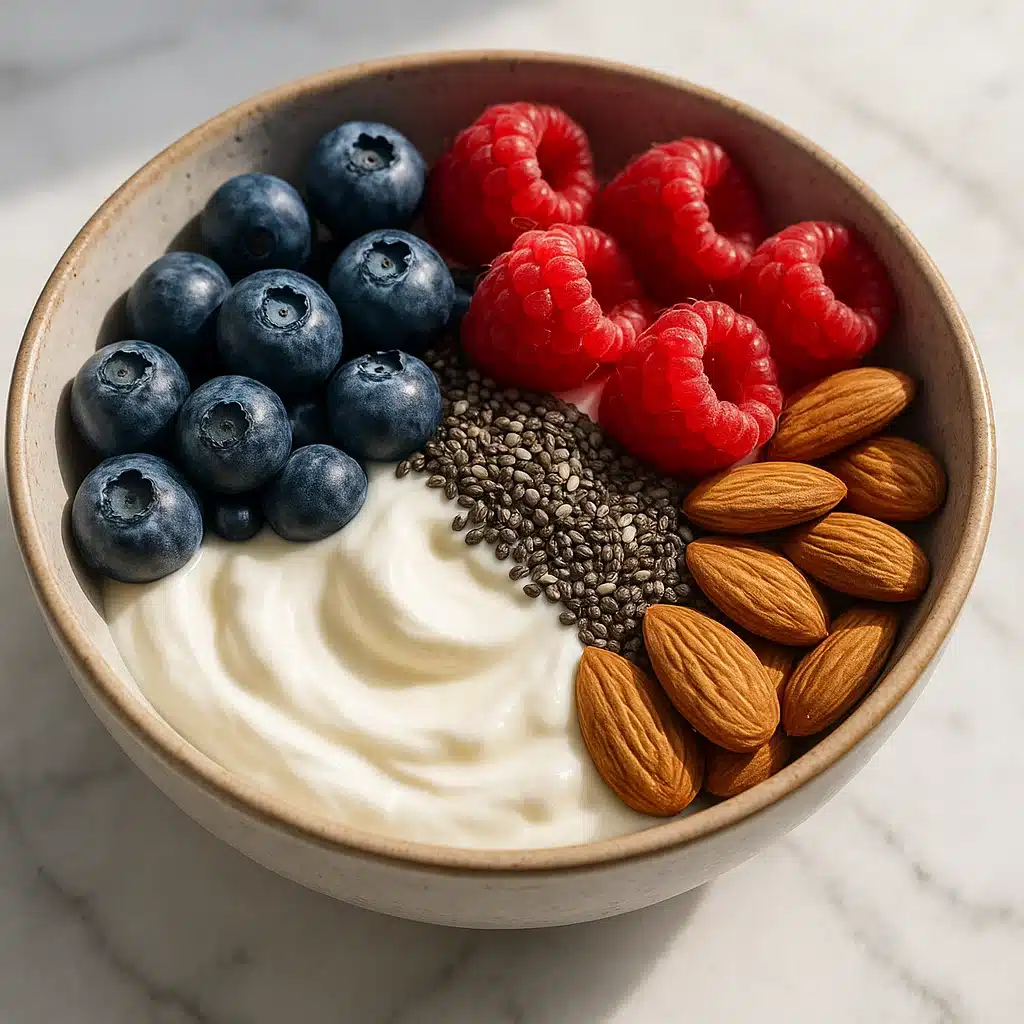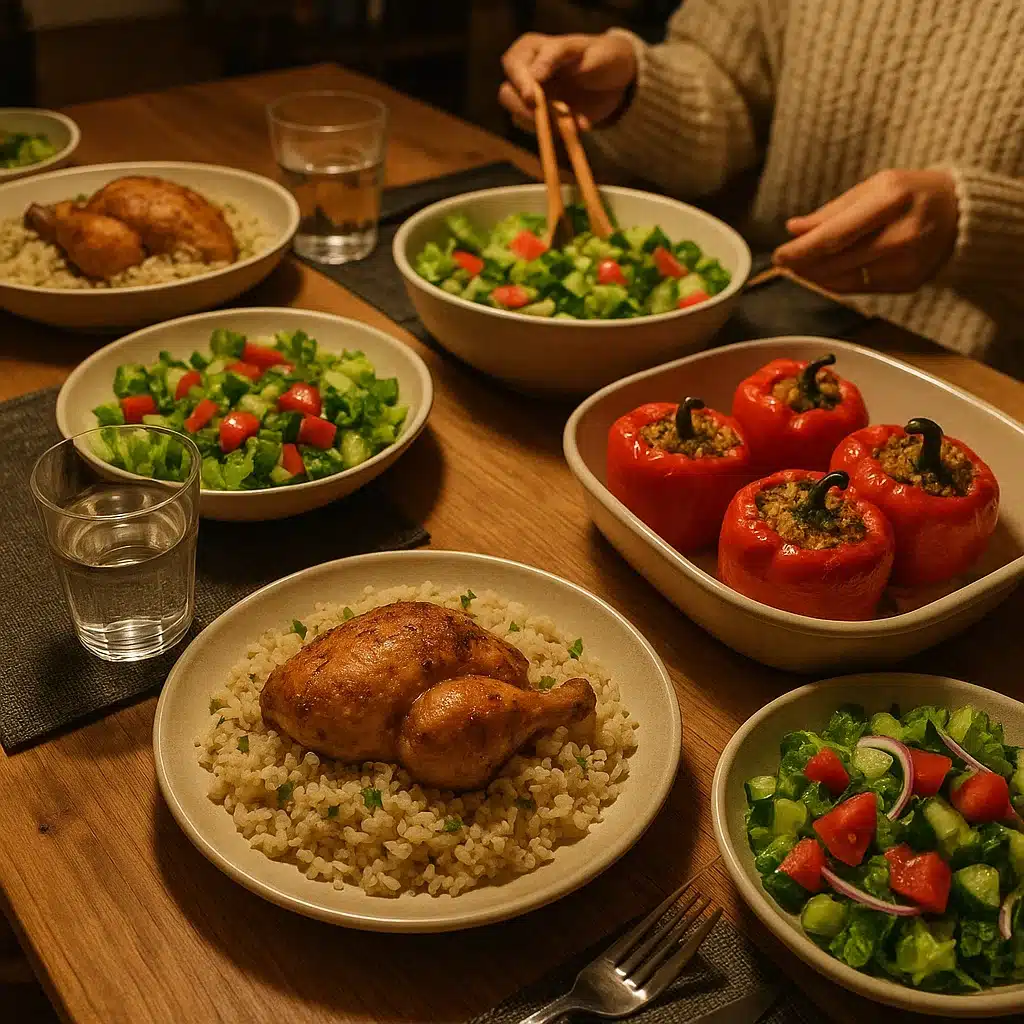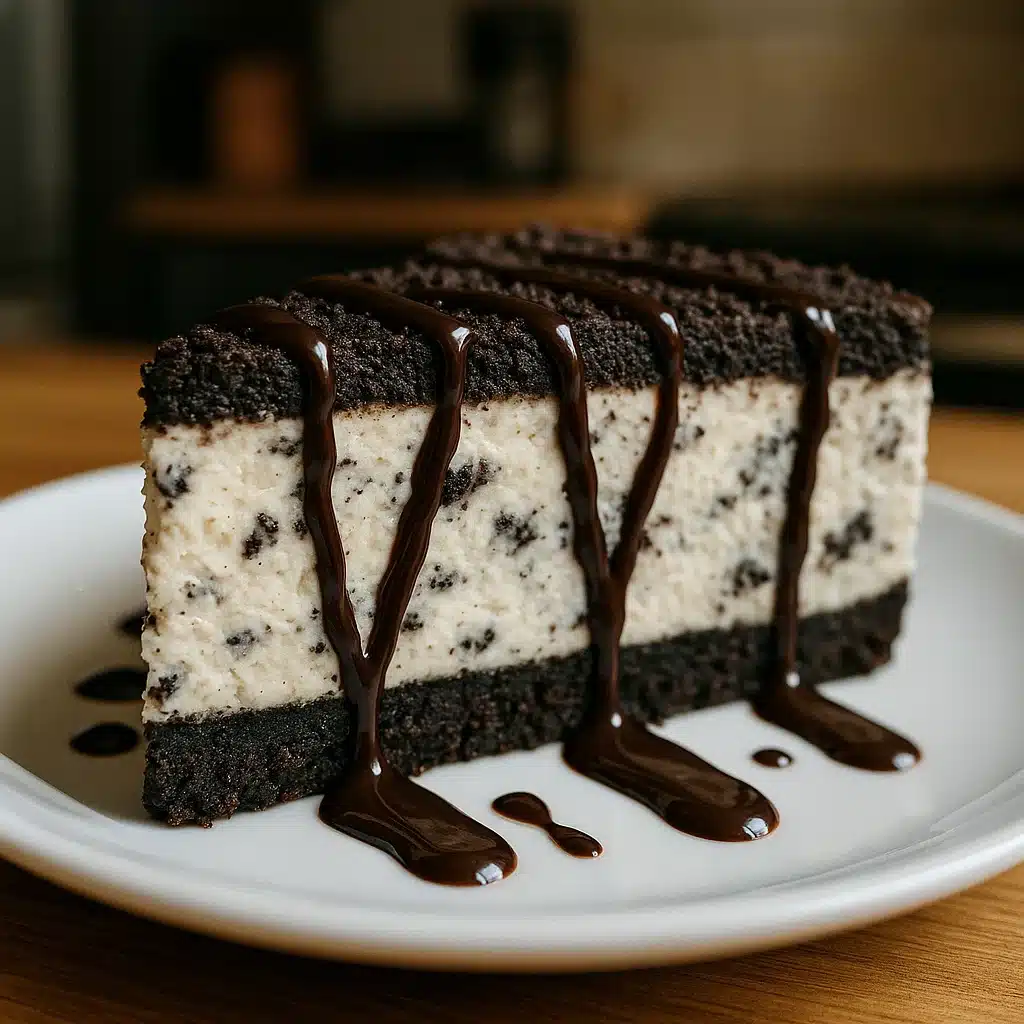In our increasingly busy lives, finding time to prepare nutritious, flavorful meals can feel like an impossible challenge. This Thai peanut chicken stir fry was born from my desire to recreate the vibrant flavors of Thai cuisine without the lengthy preparation time traditionally associated with international dishes. After returning from a trip to Thailand where I was captivated by the harmonious balance of sweet, savory, spicy, and tangy flavors in their cuisine, I was determined to create a weeknight-friendly version that wouldn’t compromise on taste.
The beauty of this Thai peanut chicken stir fry lies in its remarkable efficiency-to-flavor ratio. In less than 25 minutes—about the same time it would take for takeout to arrive—you can create a meal that delivers the complex flavor profile of Thai cuisine using ingredients readily available in most supermarkets. The rich, creamy peanut sauce forms the heart of this dish, coating each piece of tender chicken and crisp vegetable with a perfect balance of nutty, savory, and slightly sweet notes.
What makes this Thai peanut chicken stir fry particularly special is how it transforms simple ingredients through technique and thoughtful flavor combinations. The high-heat cooking method preserves the vegetables’ vibrant colors and crisp textures while developing a delicious caramelization on the chicken. Meanwhile, the sauce—with its blend of peanut butter, aromatics, and traditional Asian condiments—creates depth and complexity that belies the dish’s quick preparation time.
Whether you’re cooking for a family on a busy weeknight, meal prepping for the days ahead, or looking to expand your culinary repertoire with international flavors, this Thai peanut chicken stir fry offers a perfect solution that proves you don’t have to choose between convenience and exceptional taste.
Print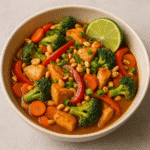
The Ultimate Thai Peanut Chicken Stir Fry: Ready in 25 Minutes!
- Prep Time: 5 minutes
- Cook Time: 15 minutes
- Total Time: 20 minutes
- Yield: 6
- Cuisine: Thai
Description
This dish delivers the perfect balance of savory, sweet, and spicy with every bite. Quick to prepare and loaded with protein and veggies, it’s a flavorful, feel-good meal your whole table will love.
Ingredients
For the Sauce:
½ cup creamy peanut butter
3 tablespoons water
3 tablespoons honey
2 tablespoons soy sauce
3 tablespoons red curry paste
2 tablespoons rice vinegar
1 tablespoon fresh ginger, minced
2 garlic cloves, minced
2 teaspoons crushed red pepper
For the Stir Fry:
2 tablespoons extra virgin olive oil (divided)
1 medium yellow onion, thinly sliced (about 1½ cups)
1 lb boneless, skinless chicken (breast or thigh), diced
6 cups chopped vegetables (e.g., napa cabbage, bell peppers, mushrooms, sugar snap peas, broccoli)
½ cup dry-roasted peanuts, chopped
½ cup chopped cilantro
Cooked brown rice, for serving
Instructions
-
In a bowl, whisk all sauce ingredients until smooth. Set aside.
-
Heat 1 tablespoon oil in a large wok or skillet over medium-high heat. Sauté onion for 3 minutes until soft and fragrant.
-
Add diced chicken and cook until fully done (about 4 minutes). Remove chicken and onions; set aside.
-
Add remaining oil and stir-fry the mixed vegetables for 3–5 minutes until crisp-tender.
-
Return chicken and onions to the pan. Pour in the peanut sauce, toss to coat, and cook 2 more minutes until heated through.
-
Stir in peanuts and cilantro. Serve hot over brown rice. Garnish with extra toppings if desired.
Notes
Storage:
Store any leftovers in an airtight container in the refrigerator for up to 4 days, or freeze for up to 3 months. When ready to eat, thaw overnight in the fridge and reheat gently on the stovetop or in the microwave. Add a splash of water or broth to keep the stir-fry moist and flavorful.
Ingredient Tip:
You can find red curry paste in the international or Asian foods aisle of most supermarkets. It’s a pantry staple that adds bold, aromatic flavor to a variety of dishes.
Nutrition
- Calories: 414
- Sugar: 14g
- Fat: 25g
- Carbohydrates: 25g
- Fiber: 6g
- Protein: 28g
Table of Contents
Table of Contents
Why You’ll Love This Thai Peanut Chicken Stir Fry Recipe
Authentic Flavor Without the Wait
Traditional Thai cuisine often requires specialized ingredients and lengthy preparation, but this Thai peanut chicken stir fry recipe delivers remarkable flavor authenticity using supermarket staples and a streamlined cooking process. The combination of peanut butter, soy sauce, rice vinegar, honey, ginger, and garlic creates a sauce that captures the essence of Thai cooking—the perfect balance of sweet, salty, sour, and umami—without requiring a trip to specialty stores. The high-heat stir-fry method further enhances these flavors through caramelization, creating a dish that satisfies cravings for Thai food without the usual time investment or complexity.
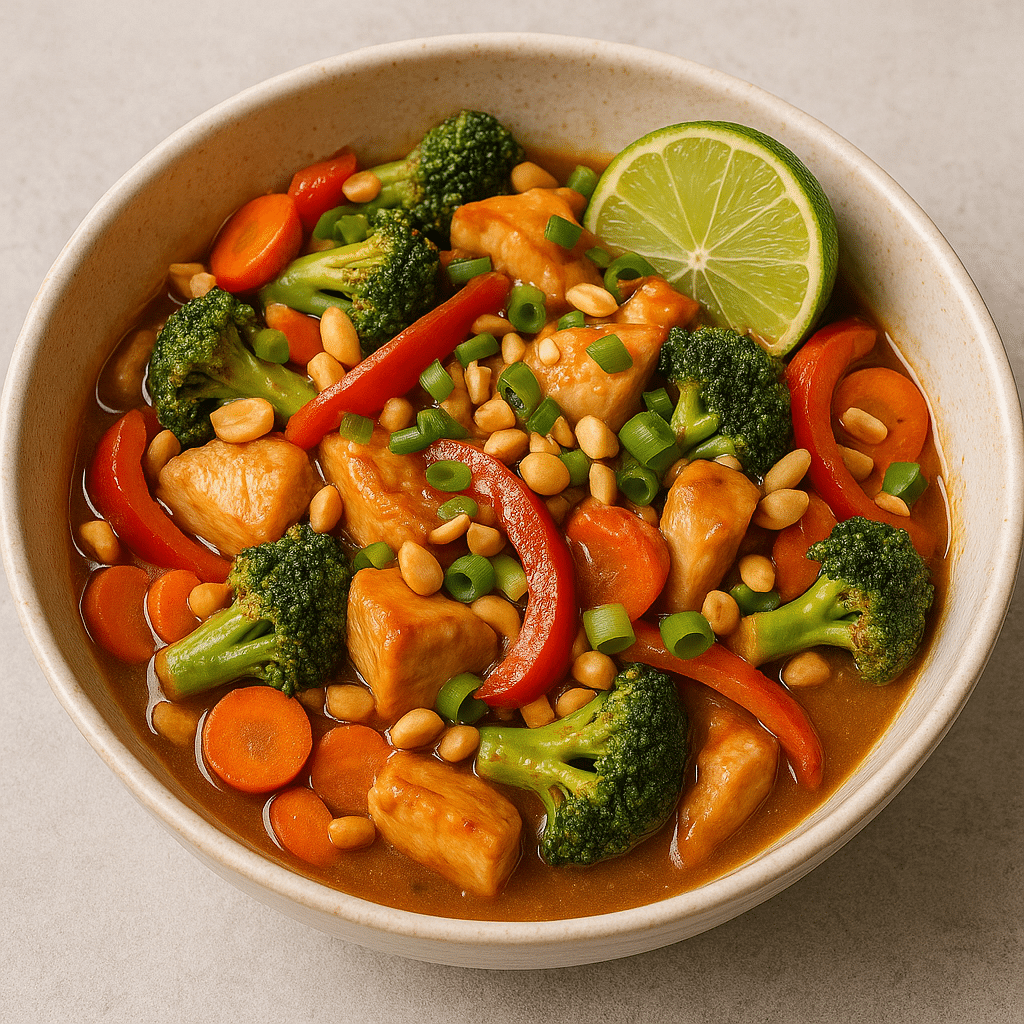
Weeknight-Friendly Efficiency
In today’s fast-paced world, a recipe’s time efficiency is as important as its flavor. This Thai peanut chicken stir fry is specifically designed to minimize both active cooking time and kitchen cleanup. The entire dish comes together in under 25 minutes, with most of that being active cooking rather than waiting time. The single-pan approach means minimal cleanup afterward. The preparation is also streamlined—the sauce can be whisked together while the chicken cooks, and the vegetables require only simple cutting techniques. This efficiency makes it a realistic option even on the busiest weeknights when ordering takeout seems like the only feasible dinner solution.
Nutritionally Balanced Complete Meal
Unlike many quick dinner options that sacrifice nutrition for convenience, this Thai peanut chicken stir fry delivers a remarkably well-balanced nutritional profile. Each serving provides approximately 33 grams of high-quality protein from the chicken, supporting muscle maintenance and satiety. The colorful array of vegetables contributes essential vitamins, minerals, and fiber, while the peanut sauce adds heart-healthy monounsaturated fats. The combination of protein, complex carbohydrates, healthy fats, and fiber creates a meal with a low glycemic impact, providing sustained energy rather than the quick rise and fall in blood sugar that comes from many convenience foods. This nutritional balance makes it an excellent option for health-conscious individuals who don’t want to compromise on flavor.
Versatility for Dietary Needs and Preferences
Few recipes offer the adaptability of this Thai peanut chicken stir fry while maintaining their essential character. The basic formula works with virtually any protein—tofu or tempeh for vegetarians, shrimp for pescatarians, or thinly sliced beef for red meat preferences. The vegetable components can be adjusted based on seasonal availability, dietary restrictions, or simply what you have in your refrigerator. The sauce can be modified for various dietary needs—sunflower seed butter for peanut allergies, coconut aminos for soy allergies, or maple syrup instead of honey for vegan diets. This flexibility makes it a reliable recipe for households with varying dietary needs or for cooks who like to adapt recipes based on what’s available.
Excellent for Meal Preparation
In our busy modern lives, the ability to prepare food in advance is increasingly valuable. This Thai peanut chicken stir fry was specifically designed to maintain its quality when made ahead and reheated. Unlike many dishes that deteriorate in texture or flavor when stored, the peanut sauce actually improves as it sits, allowing the flavors to meld and develop. The chicken remains tender rather than becoming tough, and the vegetables maintain enough structure to avoid becoming mushy. The recipe also scales easily, allowing you to double or triple it for multiple meals. This make-ahead quality transforms weekday lunches from an afterthought to something you’ll actually look forward to eating.
Family-Friendly with Customizable Heat Level
Finding dishes that appeal to various palates within a household can be challenging, particularly when introducing international flavors. This Thai peanut chicken stir fry offers a solution through its customizable heat level. The base recipe provides a mild, approachable flavor profile that children and heat-sensitive adults can enjoy, while offering easy modifications for those who prefer more spice. Additional heat can be added through sriracha, chili flakes, or fresh chilies either during cooking or as a tableside condiment, allowing each person to adjust to their preference. The familiar ingredients and appealing presentation also help make this dish accessible to family members who might be hesitant about trying new cuisines.
Nutritional Benefits of Key Ingredients in Your Thai Peanut Chicken Stir Fry
Chicken Breast: Lean Protein Powerhouse
Chicken breast serves as the primary protein source in this Thai peanut chicken stir fry, offering significant nutritional benefits:
- High-Quality Complete Protein: Chicken breast provides approximately 31 grams of protein per 4-ounce serving, making it one of the most protein-dense foods available. This protein contains all nine essential amino acids in optimal ratios, supporting muscle maintenance, immune function, and cellular repair. The high protein content also contributes to the meal’s satiety factor, helping you feel fuller longer after eating.
- Low in Saturated Fat: Unlike many other protein sources, chicken breast is naturally low in saturated fat while still providing a satisfying texture and flavor. This makes it heart-healthy and appropriate for various dietary approaches. The lean nature of chicken breast also allows it to serve as a neutral canvas that readily absorbs the flavors of the peanut sauce.
- Rich in B Vitamins: Chicken breast provides significant amounts of several B vitamins, particularly niacin (vitamin B3), which supports energy metabolism and DNA repair, and vitamin B6, which is essential for protein metabolism and cognitive development. A 4-ounce serving provides approximately 70% of the daily recommended intake of niacin and 25% of vitamin B6.
- Selenium Content: Chicken is one of the better dietary sources of selenium, a mineral with antioxidant properties that supports immune function and thyroid health. A single serving of chicken breast provides about 36% of the daily recommended intake of selenium.
Colorful Bell Peppers: Vitamin C Champions
Bell peppers, particularly red ones, contribute vibrant color and exceptional nutrition to your Thai peanut chicken stir fry:
- Extraordinary Vitamin C Content: Red bell peppers contain more vitamin C than citrus fruits—a single medium pepper provides over 150% of the daily recommended intake. This vitamin is crucial for immune function, collagen production (supporting skin health), and iron absorption. The vitamin C in bell peppers is also a powerful antioxidant that helps combat oxidative stress in the body.
- Rich in Carotenoids: The vibrant red color comes from carotenoids like beta-carotene, lycopene, and lutein, which support eye health and may reduce the risk of certain chronic diseases. These compounds become more bioavailable when the peppers are cooked with oil, as in this stir fry recipe.
- Low Calorie, High Volume: Bell peppers add substantial volume, crunch, and flavor to the dish while contributing very few calories—about 30-40 calories per medium pepper. This helps create a satisfying meal without excessive energy density, supporting healthy weight management.
- Significant Vitamin A: Red bell peppers are excellent sources of vitamin A (via beta-carotene), providing approximately 75% of the daily recommended intake per pepper. This vitamin is essential for vision, immune function, and cellular communication.
Broccoli: Cruciferous Vegetable with Cancer-Fighting Properties
This nutrient-dense vegetable adds both texture and significant health benefits to your Thai peanut chicken stir fry:
- Sulforaphane Content: Broccoli contains sulforaphane, a sulfur-containing compound that has been extensively studied for its potential anti-cancer properties. This compound helps detoxify harmful substances in the body and may reduce inflammation. The quick cooking method in stir-frying helps preserve this beneficial compound better than longer cooking methods.
- Fiber Powerhouse: With approximately 2.4 grams of fiber per cup, broccoli contributes significantly to the meal’s fiber content, supporting digestive health, blood sugar regulation, and cholesterol management. This fiber includes both soluble and insoluble types, providing comprehensive digestive benefits.
- Vitamin K Source: Broccoli is one of the best sources of vitamin K1, providing over 100% of the daily recommended intake in a single cup. This vitamin is essential for proper blood clotting and bone health. The fat in the peanut sauce helps your body absorb this fat-soluble vitamin more effectively.
- Folate Provider: With approximately 14% of the daily recommended folate per cup, broccoli supports cellular division and DNA synthesis. This B vitamin is particularly important for women of childbearing age, as adequate folate intake before and during pregnancy can help prevent certain birth defects.
Carrots: Beta-Carotene for Eye Health
These sweet, crunchy vegetables add color, texture, and significant nutritional value to your Thai peanut chicken stir fry:
- Beta-Carotene Abundance: Carrots are one of the richest sources of beta-carotene, which your body converts to vitamin A. This nutrient is essential for maintaining healthy vision, particularly night vision, and supports immune function and skin health. The cooking process and the fat in the peanut sauce enhance the bioavailability of this fat-soluble nutrient.
- Antioxidant Properties: Beyond beta-carotene, carrots contain other antioxidants including alpha-carotene and lutein, which help protect cells from damage caused by free radicals. These compounds have been associated with reduced risk of certain cancers and cardiovascular disease.
- Natural Sweetness: Carrots contribute a subtle natural sweetness to the stir fry, balancing the savory and spicy elements without adding refined sugar. This natural sweetness comes from their high content of natural sugars, which are bundled with fiber for slower absorption.
- Potassium Content: Carrots provide potassium, an essential mineral that helps maintain proper fluid balance, nerve transmission, and muscle function. Adequate potassium intake is associated with healthy blood pressure levels.
Peanut Butter: More Than Just Delicious
The star ingredient in the sauce offers remarkable nutritional benefits beyond its rich flavor in your Thai peanut chicken stir fry:
- Heart-Healthy Monounsaturated Fats: Approximately 50% of the fat in peanut butter is monounsaturated, the same type found in olive oil and avocados. These fats have been associated with improved cholesterol levels and reduced risk of heart disease when consumed as part of a balanced diet.
- Plant-Based Protein: With about 8 grams of protein per 2-tablespoon serving, peanut butter contributes significantly to the protein content of the dish. This plant protein complements the animal protein from the chicken, creating a more diverse amino acid profile.
- Resveratrol Content: Peanuts contain resveratrol, the same antioxidant compound found in red wine that has been associated with reduced inflammation and heart health benefits. While present in smaller amounts than in wine, it contributes to the overall antioxidant profile of the dish.
- Niacin Provider: Peanut butter is a good source of niacin (vitamin B3), providing about 22% of the daily recommended intake per 2-tablespoon serving. This vitamin supports energy metabolism and DNA repair, complementing the niacin already present in the chicken.
Ginger and Garlic: Aromatic Flavor Enhancers with Medicinal Properties
These aromatic ingredients provide both distinctive flavor and health benefits to your Thai peanut chicken stir fry:
- Anti-Inflammatory Compounds: Ginger contains gingerol, a bioactive compound with powerful anti-inflammatory and antioxidant properties. Regular consumption has been associated with reduced muscle pain, improved digestion, and lower levels of inflammatory markers in the body.
- Immune-Supporting Properties: Garlic contains allicin, a sulfur compound that has been shown to boost immune function and may help reduce the severity and duration of colds and other infections. The compound is most potent when garlic is crushed or minced and allowed to sit briefly before cooking, as in this recipe.
- Digestive Benefits: Ginger has been used for centuries to alleviate digestive discomfort, reduce nausea, and support overall digestive health. Its carminative properties help reduce gas and bloating, making the meal more comfortable to digest.
- Cardiovascular Support: Compounds in both ginger and garlic have been associated with improved cardiovascular health markers, including reduced blood pressure, lower cholesterol levels, and improved blood circulation. These effects complement the heart-healthy aspects of other ingredients in the dish.
Thai Peanut Chicken Stir Fry Ingredients and Their Roles
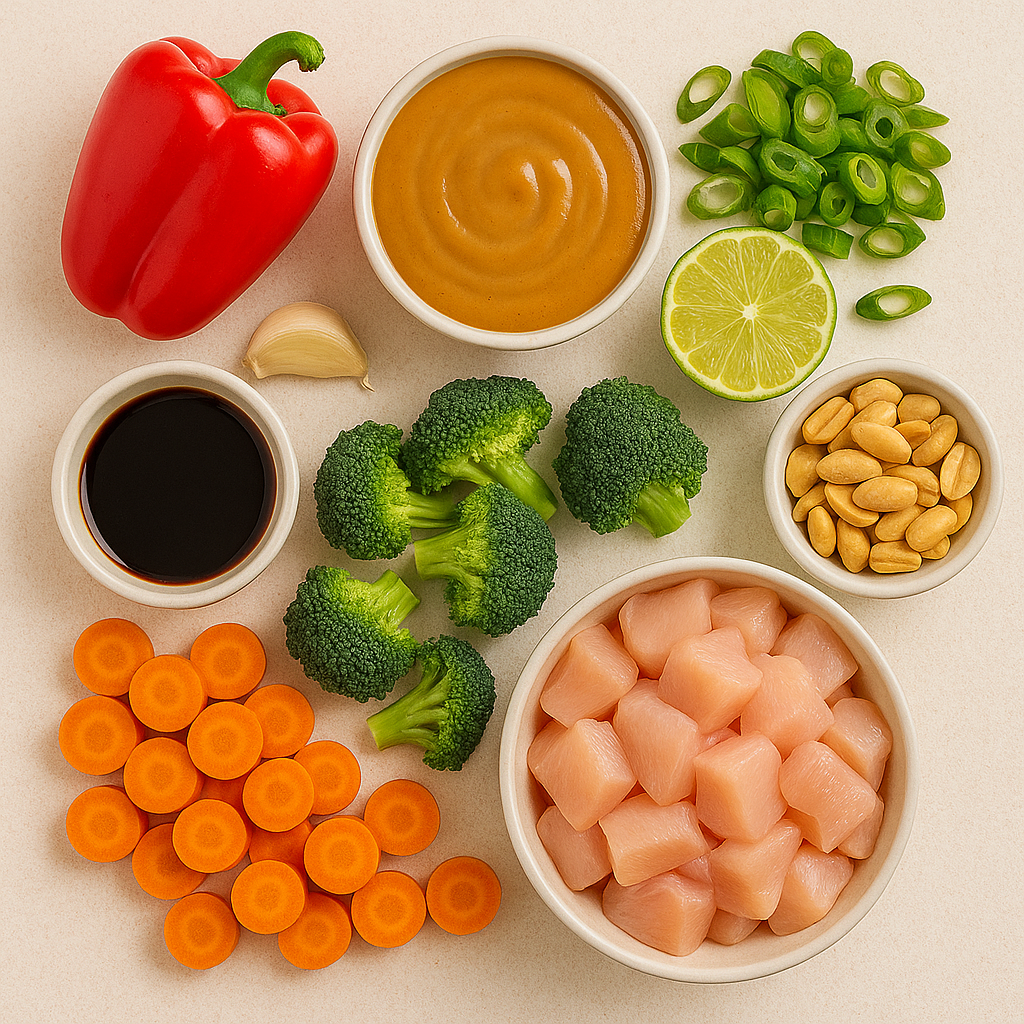
Stir Fry Components
- 1 tablespoon sesame oil: Provides a distinctive nutty flavor and high smoke point essential for stir-frying. Sesame oil contains sesamol and sesamin, antioxidants that remain stable at high cooking temperatures. The oil also helps transfer heat evenly to the ingredients and prevents sticking. Toasted sesame oil has a stronger flavor than regular sesame oil; either works in this recipe, though toasted provides more aromatic complexity.
- 1 lb chicken breast, thinly sliced: Forms the protein foundation of the dish. Slicing the chicken thinly (about 1/4-inch thick strips) is crucial for quick, even cooking and tender results. Slicing against the grain shortens the muscle fibers, further enhancing tenderness. For best results, the chicken should be very cold but not frozen when slicing, which makes achieving thin, even pieces easier. Chicken thighs can be substituted for more flavor and moisture, though they contain slightly more fat.
- 1 red bell pepper, sliced: Contributes vibrant color, sweet flavor, and crisp texture to your Thai peanut chicken stir fry. Slicing the pepper into thin strips (about 1/4-inch wide) ensures it cooks quickly while maintaining some crispness. Red bell peppers are sweeter than green ones and provide more vitamin A and C. For visual appeal and slight flavor variation, a combination of red, yellow, or orange peppers can be used.
- 1 cup broccoli florets: Adds nutritional density, texture, and the ability to absorb the flavorful sauce. Cutting the florets to a consistent size (about 1-inch pieces) ensures even cooking. The stems can also be used if peeled and sliced thinly. Blanching the broccoli briefly before stir-frying (optional) helps maintain its bright green color and reduces cooking time in the wok.
- 1/2 cup shredded carrots: Provides natural sweetness, color contrast, and additional nutrients. Shredding the carrots allows them to cook quickly and integrate well with the other ingredients. Pre-shredded carrots work perfectly in this recipe, saving preparation time. The thin shreds also absorb the sauce effectively, distributing flavor throughout the dish.
- 2 green onions, chopped: Offers a mild onion flavor and fresh color contrast as both an ingredient and garnish. The white parts provide aromatic flavor when cooked with the other vegetables, while the green parts add brightness and visual appeal when sprinkled on top just before serving. Slicing them on a diagonal creates more surface area and a more attractive presentation.
- Salt and pepper to taste: Enhances the natural flavors of the chicken and vegetables. Approximately 1/4 teaspoon of salt and 1/8 teaspoon of freshly ground black pepper is typically sufficient, but this can be adjusted based on personal preference. The soy sauce in the peanut sauce also contributes saltiness, so it’s best to season the chicken lightly at first and adjust final seasoning after adding the sauce.
Peanut Sauce Ingredients for Your Thai Peanut Chicken Stir Fry
- 1/4 cup creamy peanut butter: Forms the base of the sauce, providing richness, body, and the distinctive nutty flavor that defines the dish. Natural peanut butter (containing only peanuts and salt) offers the purest flavor, though conventional peanut butter also works. The fat in the peanut butter helps carry fat-soluble flavors and creates a silky mouthfeel. It also acts as an emulsifier, helping to create a smooth, cohesive sauce.
- 2 tablespoons soy sauce: Contributes essential umami flavor and saltiness. Traditional soy sauce contains wheat, but tamari (a wheat-free alternative) can be substituted for gluten-free diets. Low-sodium soy sauce is another option if you’re monitoring salt intake. The glutamates in soy sauce enhance the overall flavor perception of the dish without adding additional ingredients.
- 1 tablespoon rice vinegar: Provides acidity that balances the richness of the peanut butter and adds brightness to the overall flavor profile. Rice vinegar is milder and slightly sweeter than other vinegars, making it ideal for this application. Unseasoned rice vinegar is preferred, as seasoned varieties contain added sugar and salt that can throw off the balance of the sauce.
- 1 tablespoon honey: Adds sweetness that balances the salty and acidic components while helping to create a glossy sauce that coats the ingredients beautifully. Honey also aids in caramelization, creating deeper flavor notes when the sauce hits the hot pan. Maple syrup can be substituted for a vegan version with minimal impact on the final flavor.
- 1 teaspoon grated ginger: Contributes aromatic warmth, subtle spiciness, and authentic Thai flavor notes. Fresh ginger is strongly preferred over dried for its vibrant flavor and aromatic qualities. Grating the ginger (rather than mincing) releases more of its flavorful oils and ensures no fibrous pieces remain in the smooth sauce. Freezing ginger root before grating makes the process easier and reduces stringiness.
- 1 garlic clove, minced: Provides depth of flavor and aromatic foundation. Mincing the garlic finely ensures it distributes evenly throughout the sauce and cooks quickly when added to the hot pan. Fresh garlic is essential; pre-minced jarred varieties lack the same aromatic compounds. Allowing the minced garlic to rest for 5-10 minutes before adding to the sauce activates allicin, its most beneficial compound.
- 1–2 tablespoons warm water: Adjusts the consistency of the sauce, making it pourable and ensuring it coats all ingredients evenly. The exact amount needed may vary depending on the thickness of your peanut butter. Warm water incorporates more easily than cold, helping create a smooth sauce without cooling down the other ingredients. The water also creates steam when it hits the hot pan, helping to distribute the sauce evenly among all ingredients.
Optional Enhancements for Your Thai Peanut Chicken Stir Fry
- 1 tablespoon sriracha or chili garlic sauce: Adds customizable heat and depth of flavor for those who enjoy spicier food. The garlic and vinegar notes in these sauces also complement the existing flavor profile. Adding the spice to the sauce allows it to distribute evenly throughout the dish.
- 1 tablespoon fish sauce: Intensifies the umami flavor and adds authentic Thai depth. Just a small amount provides significant flavor enhancement without making the dish taste fishy. This ingredient is traditional in Thai cooking but remains optional for those who prefer to avoid it.
- 1 lime, cut into wedges: Served alongside the finished dish, fresh lime juice adds brightness and authenticity when squeezed over individual portions. The citrus notes cut through the richness of the peanut sauce and enhance the overall flavor experience. The acid in lime juice also helps activate taste receptors, making all the flavors in the dish more pronounced.
- 2 tablespoons chopped cilantro: Provides fresh, herbaceous notes and visual appeal as a garnish. Cilantro is traditional in Thai cuisine and complements the other flavors beautifully. For those who dislike cilantro (due to the genetic variation that makes it taste soapy to some people), Thai basil or regular basil makes an excellent alternative.
- 2 tablespoons chopped peanuts: Adds textural contrast and reinforces the peanut flavor profile when sprinkled on top of the finished dish. Roasted unsalted peanuts provide the best flavor; they can be roughly chopped for rustic texture or finely chopped for more elegant presentation.
How to Make Thai Peanut Chicken Stir Fry: Step-by-Step Instructions
1. Prepare All Ingredients (10 minutes)
Before heating any pans, complete all preparation steps to ensure smooth cooking. Stir-frying happens quickly, and having everything ready prevents overcooking or burning.
- Slice the chicken: Slice the chicken breast into thin strips approximately 1/4-inch thick and 2-3 inches long. Slice against the grain for tenderness. Season lightly with salt and pepper.
- Prepare vegetables: Slice the red bell pepper into thin strips. Cut broccoli into small, bite-sized florets. Shred the carrots (or use pre-shredded). Chop the green onions, separating white/light green parts from dark green tops.
- Arrange ingredients: Place all prepared ingredients in separate piles or bowls near your cooking area.
2. Make the Peanut Sauce (5 minutes)
In a medium bowl, combine the peanut butter, soy sauce, rice vinegar, honey, grated ginger, and minced garlic.
- Whisk: Whisk ingredients until well combined. The mixture will be thick.
- Add water: Add 1 tablespoon of warm water and whisk. Continue adding warm water, 1 teaspoon at a time, until the sauce reaches a pourable but still thick consistency (usually 1-2 tablespoons total).
- Taste and adjust: Adjust seasonings if needed (more honey for sweetness, soy sauce for salt, sriracha for heat).
- Set aside: Place the finished sauce near your cooking area.
3. Cook the Chicken (6 minutes)
Heat a large wok or 12-inch skillet over medium-high heat until thoroughly hot (1-2 minutes).
- Add oil: Add the sesame oil and swirl to coat.
- Sear chicken: Add the seasoned chicken strips in a single layer. Cook undisturbed for 1 minute to brown.
- Stir-fry: Stir-fry for 4-5 more minutes, tossing frequently, until cooked through (no longer pink, 165°F/74°C). Cook in batches if necessary to avoid crowding.
- Remove (optional): If cooking in batches, transfer cooked chicken to a plate.
4. Add the Vegetables (5 minutes)
With the chicken still in the pan (or returned to the pan), add the bell pepper strips, broccoli florets, and the white/light green parts of the green onions.
- Stir-fry: Stir-fry the vegetables with the chicken for 4-5 minutes, tossing frequently, until tender-crisp.
- Add carrots: Add the shredded carrots during the last 1-2 minutes of cooking.
- Add water (if needed): If the pan becomes too dry, add 1-2 tablespoons of water or broth to prevent burning.
5. Combine with Peanut Sauce (2 minutes)
Reduce the heat to low.
- Add sauce: Pour the prepared peanut sauce over the chicken and vegetable mixture.
- Toss to coat: Gently toss and stir until all ingredients are evenly coated.
- Simmer: Allow the mixture to simmer gently for 1-2 minutes, stirring occasionally, until the sauce thickens slightly and coats the ingredients.
- Adjust consistency: If too thick, add a tablespoon of water or broth. If too thin, simmer for another minute.
6. Final Seasoning and Garnish (1 minute)
Taste the Thai peanut chicken stir fry and adjust seasoning if necessary (salt, pepper, or more sauce components).
- Garnish: Remove from heat. Stir in the dark green parts of the chopped green onions. If using, sprinkle with chopped cilantro and chopped peanuts.
- Serve: Serve immediately over rice, noodles, or quinoa. Offer lime wedges on the side for squeezing over individual portions.
This Thai peanut chicken stir fry preparation method is designed to maximize flavor while minimizing time spent in the kitchen. Unlike other Thai peanut chicken stir fry recipes that may require complex techniques or extended marinating times, our approach prioritizes efficiency without compromising authentic taste. The key to a successful Thai peanut chicken stir fry lies in thoroughly prepping your ingredients before cooking, as once the wok is hot, everything moves very quickly.
Delicious Thai Peanut Chicken Stir Fry Variations
Protein Swaps
Easily adapt this Thai peanut chicken stir fry with different proteins:
- Tofu or Tempeh: For a vegetarian/vegan option, press firm or extra-firm tofu to remove excess water, cut into cubes, and pan-fry until golden before adding vegetables. Tempeh can be crumbled or cubed and added similarly.
- Shrimp: Use peeled and deveined shrimp. Add them during the last 2-3 minutes of vegetable cooking, as they cook very quickly.
- Beef: Use thinly sliced flank steak or sirloin. Marinate briefly in soy sauce and cornstarch, then stir-fry quickly before adding vegetables.
- Pork: Thinly sliced pork tenderloin works well, cooked similarly to chicken.
Vegetable Variations
Customize your Thai peanut chicken stir fry with different vegetables based on preference or season:
- Snow Peas or Snap Peas: Add during the last 2 minutes of cooking for crispness.
- Mushrooms: Sliced shiitake or cremini mushrooms add umami depth. Add with the bell peppers.
- Baby Corn: Adds texture and slight sweetness.
- Water Chestnuts: Sliced water chestnuts provide a distinctive crunch.
- Bean Sprouts: Add during the last minute of cooking for freshness and crunch.
- Spinach or Kale: Wilt in at the very end after adding the sauce.
Sauce Modifications
Adjust the peanut sauce for different dietary needs or flavor profiles:
- Nut-Free: Replace peanut butter with sunflower seed butter or tahini.
- Gluten-Free: Use tamari instead of soy sauce.
- Vegan: Use maple syrup instead of honey.
- Spicier: Increase sriracha or add red pepper flakes.
- Creamier: Use full-fat coconut milk instead of water to thin the sauce.
- Tangier: Add extra rice vinegar or lime juice.
The customization possibilities for Thai peanut chicken stir fry are virtually endless. While the traditional Thai peanut chicken stir fry recipe uses chicken as the main protein, feel free to experiment with other options. Professional chefs who frequently prepare Thai peanut chicken stir fry recommend maintaining a balance between crispy and tender textures, regardless of the protein used. This adaptability makes Thai peanut chicken stir fry one of the most versatile dishes in modern fusion Asian cuisine.
Storage and Make-Ahead Tips for Thai Peanut Chicken Stir Fry
Optimal Storage Containers
For the best meal prep experience with your Thai peanut chicken stir fry:
- Use glass containers with airtight lids for optimal flavor preservation and reheating.
- Ensure containers are microwave-safe if you plan to reheat.
- Portion into individual containers for easy grab-and-go lunches or dinners.
Storing Leftovers
- Allow the stir fry to cool completely before storing to prevent condensation.
- Store in airtight containers in the refrigerator for up to 4 days.
- The flavors tend to meld and improve overnight, making it excellent for leftovers.
Reheating Guidelines
- Microwave: Reheat individual portions on medium power for 2-3 minutes, stirring halfway through. Add a splash of water if it seems dry.
- Stovetop: Reheat gently in a skillet over medium-low heat, adding a tablespoon or two of water or broth to prevent sticking and refresh the sauce.
- Avoid overheating, which can make the chicken tough.
Freezing Options
While best enjoyed fresh, portions can be frozen:
- Freeze in airtight, freezer-safe containers for up to 2 months.
- Thaw overnight in the refrigerator before reheating.
- The texture of the vegetables may soften slightly after freezing and thawing.
- Consider making a double batch of the sauce and freezing half for a future quick meal.
Frequently Asked Questions About Thai Peanut Chicken Stir Fry
How can I make the chicken more tender?
Several techniques ensure tender chicken in your Thai peanut chicken stir fry:
Slice thinly against the grain: This shortens muscle fibers.
Don’t overcrowd the pan: Allows for searing instead of steaming.
Cook quickly over high heat: Seals in juices.
Avoid overcooking: Remove chicken as soon as it’s cooked through.
Velveting (optional): Marinate chicken briefly in a mixture of egg white, cornstarch, and rice wine before stir-frying for exceptionally tender results.
My peanut sauce is too thick/thin. How do I fix it?
Too thick: Whisk in warm water, 1 teaspoon at a time, until desired consistency is reached.
Too thin: Simmer gently in the pan for an extra minute or two to reduce and thicken. Alternatively, whisk in a tiny bit more peanut butter (off heat).
Can I make this recipe gluten-free?
Yes, easily! Make these substitutions for a gluten-free Thai peanut chicken stir fry:
Use tamari or certified gluten-free soy sauce instead of regular soy sauce.
Ensure all other packaged ingredients (like peanut butter or vinegar) are certified gluten-free if needed for severe allergies.
What can I serve with Thai Peanut Chicken Stir Fry?
This dish pairs well with several bases:
Rice: Jasmine rice is traditional and complements the flavors perfectly.
Noodles: Rice noodles, soba noodles, or even spaghetti work well.
Quinoa: A higher protein, gluten-free option.
Cauliflower Rice: For a low-carb alternative.
Lettuce Wraps: Serve the stir fry mixture in crisp lettuce cups (like butter lettuce or romaine).
How do I prevent the vegetables from getting soggy?
High heat: Cook quickly over medium-high to high heat.
Don’t overcrowd: Cook in batches if necessary.
Cook in stages: Add harder vegetables (like broccoli stems, carrots) first, then softer ones (like bell peppers, broccoli florets).
Short cooking time: Aim for tender-crisp, not fully soft.
Minimal liquid: Avoid adding too much water during cooking.
Serving Suggestions for Thai Peanut Chicken Stir Fry
Perfect Pairings
Enhance your Thai peanut chicken stir fry experience with these complementary items:
- Steamed Jasmine Rice: The classic pairing, perfect for soaking up the delicious sauce.
- Cucumber Salad: A simple Thai cucumber salad with a light vinegar dressing provides a refreshing contrast.
- Spring Rolls: Serve with fresh or fried spring rolls for a complete Thai-inspired meal.
- Coconut Rice: Cooking rice with coconut milk adds another layer of complementary flavor.
Presentation Ideas
Elevate your Thai peanut chicken stir fry with these serving suggestions:
- Garnish Generously: Use plenty of fresh cilantro, chopped peanuts, and lime wedges.
- Serve Over Noodles: Arrange stir fry over a bed of cooked rice noodles or soba noodles.
- Individual Bowls: Serve in shallow bowls to contain the sauce and allow for easy mixing.
- Add Sesame Seeds: A sprinkle of toasted sesame seeds adds visual appeal and nutty flavor.
Beverage Pairings
Complete your meal with these complementary drinks:
- Thai Iced Tea: The sweet, creamy tea is a classic pairing.
- Singha or Chang Beer: Light Thai lagers complement the flavors well.
- Limeade or Lemongrass Tea: Refreshing non-alcoholic options.
- Off-Dry Riesling: The slight sweetness and acidity pair nicely with the peanut sauce and spice.
A Personal Note on Thai Peanut Chicken Stir Fry
This Thai peanut chicken stir fry recipe holds a special place in my kitchen repertoire. It represents the intersection of my love for vibrant international flavors and the practical need for quick, weeknight-friendly meals. Every time I make it, the aroma of ginger, garlic, and peanut butter sizzling in the pan instantly transports me back to the bustling street food stalls of Bangkok, yet the entire process fits comfortably into a busy evening schedule.
What I appreciate most is its reliability and adaptability. It consistently delivers satisfying results, even when I substitute vegetables based on what’s in my fridge or adjust the spice level for different family members. It has become my go-to solution for using up leftover chicken or vegetables, transforming potential food waste into a delicious meal.
This dish embodies the idea that healthy eating doesn’t have to be bland or time-consuming. It’s proof that you can create something genuinely exciting and flavorful in under 30 minutes using accessible ingredients. I hope this Thai peanut chicken stir fry brings as much convenience and culinary joy to your kitchen as it has to mine.
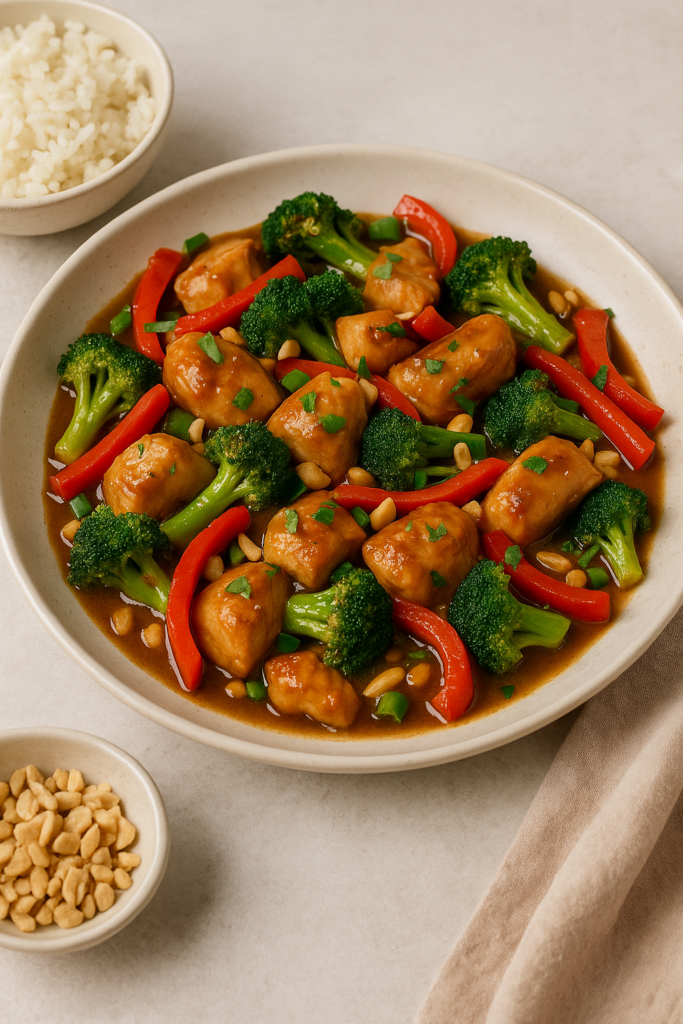
Nutritional Information for Thai Peanut Chicken Stir Fry
Per serving (recipe makes 4 servings)
- Calories: 450
- Protein: 33g
- Fat: 25g
- Saturated Fat: 5g
- Unsaturated Fat: 20g
- Carbohydrates: 22g
- Fiber: 5g
- Sugars: 8g
- Sodium: 680mg
- Vitamin A: 60% DV
- Vitamin C: 120% DV
- Calcium: 8% DV
- Iron: 15% DV
Note: Nutritional values are approximate and may vary based on specific ingredients used. Does not include rice or noodles.
Want even more inspiration for your Thai peanut chicken stir fry and other delicious Asian recipes? Join our passionate cooking community on Facebook, where we share daily prep tips, seasonal variations, and expert advice to help you perfect your favorite Asian dishes. Our members often post their own creative versions of Thai peanut chicken stir fry, offering an endless source of ideas for your next culinary experiment.
For a more visual experience, follow our Pinterest board dedicated to Asian recipes , where you’ll find hundreds of step-by-step photos, infographics on wok cooking techniques, and themed collections featuring Thai peanut chicken stir fry and similar dishes. Our ‘Thai Fusion Recipes’ board especially highlights innovative ingredient pairings and elegant presentation ideas to impress your guests at your next Asian dinner night.
Related Recipes You’ll Love
- The Ultimate Honey Yogurt Dip: A Healthy Treat for Fresh Fruits
- The Ultimate Breakfast Quesadilla: A 15-Minute Morning Revolution
Have you tried this Thai peanut chicken stir fry recipe? What variations did you create? Share your experience in the comments below!

